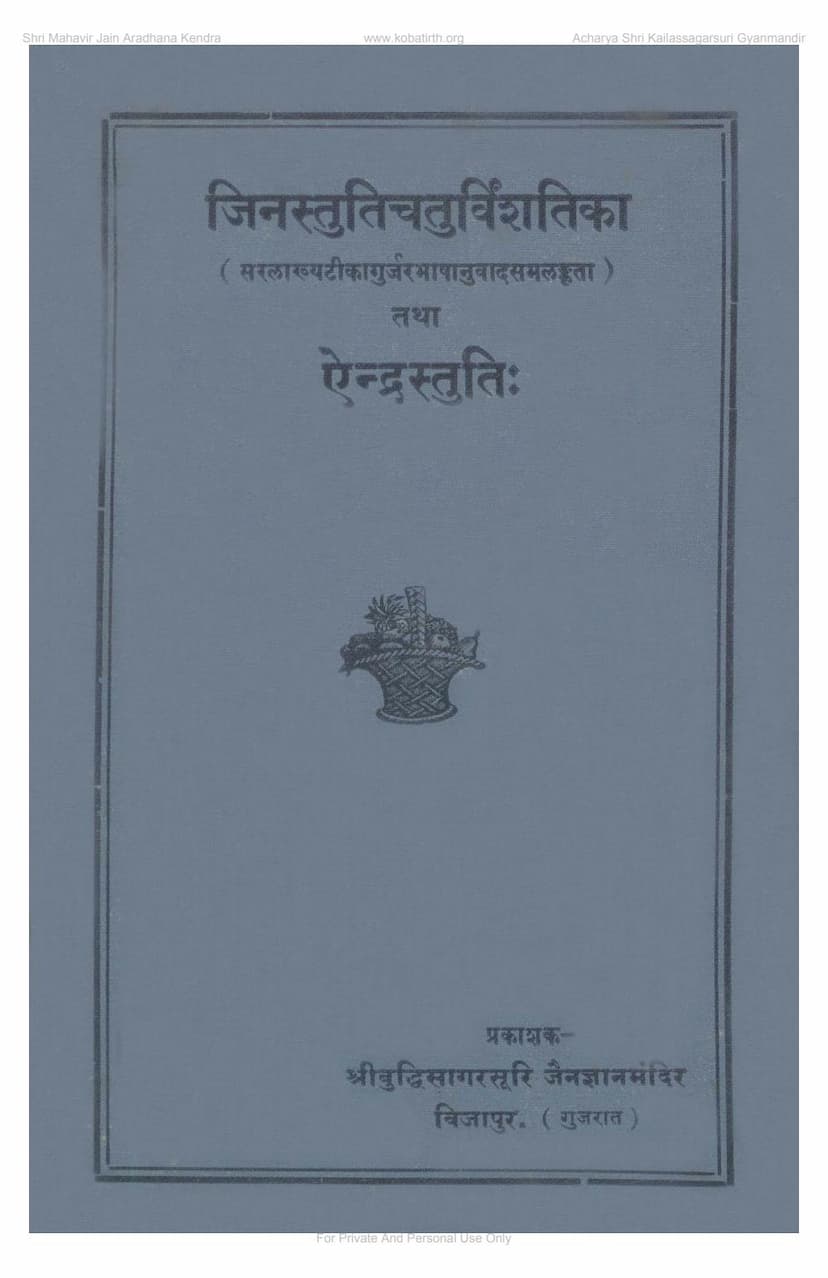Jina Stuti Chaturvinshtika
Added to library: September 2, 2025

Summary
This is a comprehensive summary of the Jain text "Jina Stuti Chaturvinshtika" based on the provided pages.
Book Title: Jina Stuti Chaturvinshtika (जिनस्तुतिचतुर्विंशतिका)
Author(s): Shobhanmuni (शोभनमुनीश्वर), Ajitsagarsuri (श्रीमदजितसागरसूरि)
Publisher: Buddhisagarsuri Jain Gyanmandir (श्रीबुद्धिसागरसूरि जैनज्ञानमंदिर)
Series: Shri Ajitsagarsuri Jain Granthmala Series No. 17
Publication Details:
- First Edition: Vikram Samvat 1991 (1935 A.D.)
- Copies Printed: 1000
- Price: Rs. 1-8-0
Content and Structure:
The book presents the "Jina Stuti Chaturvinshtika," a collection of prayers dedicated to the twenty-four Tirthankaras, originally composed by the learned Jain monk Shobhanmuni. The core of the work is enhanced by a Sanskrit commentary titled "Sarala" (सरलाख्यटीका) and a Gujarati translation thereof, both authored by Shrimad Ajitsagarsuri. The compilation and research were done by Muni Hamendrasagar.
Key Aspects Highlighted in the Text:
-
The Author, Shobhanmuni:
- Shobhanmuni is described as a highly talented poet, possessing innate poetic abilities.
- He was the younger brother of the renowned poet Dhanpal, who was a close friend of King Bhoja.
- Shobhanmuni was born into a learned Vedic Brahmin family, likely in Ujjain. His grandfather, Devarshi, lived in Sankashya.
- His father, Sarvadeva, was a scholar who resided in Dhara, the capital of King Bhoja.
- Shobhanmuni's life story is intertwined with a narrative of spiritual awakening. His father, Sarvadeva, seeking buried treasure, encountered the Jain Muni Mahendrasuriji. In gratitude for the muni's guidance, Sarvadeva offered half the treasure, which was refused. The muni then asked for one of Sarvadeva's sons as a disciple. Shobhan, the younger son, willingly accepted this path, leading to his initiation into Jainism.
- His conversion and initiation caused friction with his elder brother, Dhanpal, and his father, but ultimately, through Shobhan's eloquence and knowledge, Dhanpal was also drawn to Jainism.
- Shobhanmuni's conversion and subsequent life as a Jain monk were pivotal, as it is believed to have influenced his brother Dhanpal to become a devout follower and writer on Jain tenets.
- Tragically, Shobhanmuni passed away at a young age, leaving behind only the "Jina Stuti Chaturvinshtika" as his known literary contribution. His intense focus on composing these stutis is evidenced by an anecdote where he, lost in thought, visited the same lay follower's house thrice for alms.
- The text acknowledges differing opinions among various ancient texts regarding Shobhanmuni's birthplace, father, and guru, but leans towards Mahendrasuriji as his diksha guru, supported by Dhanpal's Tilakamanjari.
-
The Commentary and Translation, Ajitsagarsuri:
- Shrimad Ajitsagarsuri, a disciple of Acharya Shri Buddhisagarsuriji, is praised for his interest in Jain poetical works and research.
- The "Sarala" commentary is described as lucid and commendable, successfully preserving the spirit of the original work. It aims for simplicity and clarity in explaining the verses.
- The Gujarati translation is also highly praised for its lucidity and accuracy.
- Ajitsagarsuri's dedication to this work is evident, though he unfortunately did not live to see its publication.
-
The "Jina Stuti Chaturvinshtika":
- The work consists of prayers to the twenty-four Tirthankaras.
- Each prayer is composed of four verses: one addressed to the specific Tirthankara, one to all twenty-four Tirthankaras, one to the holy scriptures (Jain Agamas), and one to a specific guardian goddess.
- The composition is noted for its artistic merit, utilizing eighteen different types of verse forms, rhetorical figures, and meters. Alliteration and intricate wordplay (Yamak and Anupras) are highlighted.
- The quality of Shobhanmuni's poetry is such that even Western scholars like Dr. Hermann Jacobi have acknowledged its brilliance, stating that these hymns alone are sufficient to secure his reputation as a great versifier.
- The text is considered to have significant historical value, shedding light on contemporary Jain thought and literature.
-
The Publisher and Supporters:
- Shree Buddhisagarsuri Jain Gnana Mandir, Vijapur, Gujarat, published this work.
- The publication was motivated by a desire to promote Jain knowledge and make valuable ancient literature accessible.
- Muni Hamendrasagar played a crucial role in researching and editing the manuscript, including obtaining the commentary from Ajitsagarsuri's devoted disciple.
- Appreciation is expressed to Muni Himanshusagari (for the Gujarati preface), Muni Himanshu Vijayji (for the Gujarati preface), and Upadhyay Shri Siddhimuni ji (for valuable suggestions).
- Rao Raja Vadilal Mohanlal Shah, B.A., LL.B., Nyayadhish of Mansa State, contributed an English preface.
- Yashwantsingh, General Adviser, Mansa State, also provided a foreword.
-
The Overall Purpose and Impact:
- The publication aims to bring forth valuable Jain literature that might otherwise remain hidden due to a lack of research.
- The commentary and translation are intended to aid students and enthusiasts in understanding this complex work.
- The publishers express a desire to publish more works by Acharya Shri Ajitsagarsuri and others to spread knowledge, appealing for generous support from the public for this endeavor.
In essence, the book is a scholarly presentation of a significant Jain devotional text, enhanced by a detailed commentary and translation, providing insights into the life of the poet-monk Shobhanmuni, the scholarly contributions of Ajitsagarsuri, and the rich literary and spiritual heritage of Jainism.